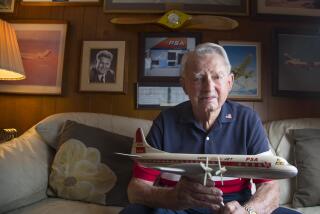Daredevils Flew by the Seat of Their Pants, Carried U.S. Mail 75 Years Ago : Postal Service: Forty-three pilots and mechanics were killed between 1918 and 1927. There were 6,500 forced landings in first five years.
- Share via
BELLEFONTE, Pa. — Now it seems so effortless--you drop a letter in a mailbox, someone picks it up and, days later, it arrives hundreds of miles away.
But 75 years ago, when air mail service began, there was nothing easy about it. And the air mail pilots of that era risked their lives with every flight.
“They were daredevils. That’s the best way to put it,” said Bob Outlaw of Chicago, a member of the American Air Mail Society, a group of history buffs, stamp collectors and aviators. “It borders on craziness.”
Forty-three pilots and mechanics in the airmail service were killed between 1918 and 1927. There also were 6,500 forced landings due to weather and mechanical trouble in the service’s first five years.
“We’re really indebted to these pioneers leading the way,” said Greg Frey, a spokesman for the U.S. Postal Service in Philadelphia. “When you look back to that period, that was uncharted territory. There were no rules. No regulation. No real guidelines. No real airports.”
The U.S. Postal Service now ships more than 3.1 billion pieces of mail by air each year, a big change from the days when 200-pound sacks rode in one cockpit while the pilot worked in another.
Regularly scheduled airmail service was established May 15, 1918, connecting New York, Philadelphia and Washington. Army pilots flew the route until Aug. 10, 1918, when civilian pilots took over.
When “pathfinder” flights between New York and Chicago began on Sept. 5, 1918, fog, snow, ice and mountains did their worst to keep the aerial couriers from their appointed rounds.
“At the time they could only land in the day. You were limited by how far the plane could go and how much daylight you had,” Outlaw said. “And weather was No. 1. You’ll see a postmark from a specific day, but many times the letter didn’t get out until three days later because of the weather.”
The first pilot killed, Carl B. Smith, died Dec. 16, 1918, in an accident attributed to inexperience. The second, Frank McCusker, jumped from his plane at 200 feet after it caught fire May 25, 1919.
“They had to be daredevils, you understand,” said Charlie Gates, a ground crew member at the Bellefonte field. In an interview before his death in 1985 at age 90, he told the Centre Daily Times newspaper: “They literally had to fly by the seat of their pants in those days. On a clear night they’d look down and follow the fence posts.”
Walter (Max) Miller of Bellefonte (who died in a 1920 airmail accident over New Jersey) blazed the trail to Chicago--sort of.
There were refueling stops every 200 miles; the first was in Lock Haven, Pa. On a 745-mile test flight that should have taken 11 hours, Miller got lost at Danville--45 miles shy of Lock Haven--and had to land to ask for directions.
The mail made it only to Cleveland before night fell, then finally to Chicago the next day.
The trip didn’t go much quicker once regularly scheduled service was launched Dec. 18, 1918, via the new government field at Bellefonte.
“On Dec. 18, Leon Smith piloted the first leg of the New York-Chicago trip. . . . (After developing engine trouble, he) turned back to Belmont Park, changed planes, got lost and landed at State College, Pa. The mail missed the connecting flight at Bellefonte and was sent to Chicago by train,” according to an American Air Mail Society history of the event.
Despite the trouble in the early flights, the mail had to go through. A post office telegram on the death of pilot Charles Ames on Oct. 1, 1925, first gave details of where and when his plane was found (six miles northeast of Bellefonte on the side of Nittany Mountain), then added:
“The mail has been brought in. It was not damaged and is being forwarded to Chicago.”
More to Read
Sign up for The Wild
We’ll help you find the best places to hike, bike and run, as well as the perfect silent spots for meditation and yoga.
You may occasionally receive promotional content from the Los Angeles Times.






